Mapledene Memories
Life in a Birmingham primary school 1953 - 1960
First Day
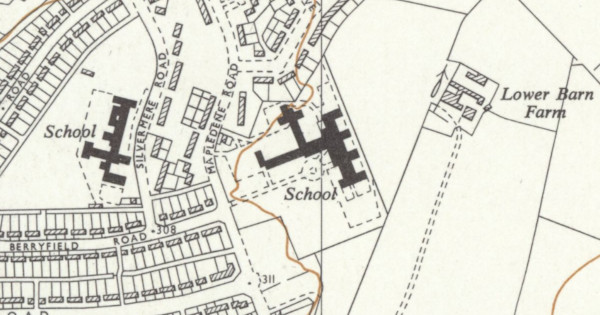
Sometime in September 1953 my mum strapped my sister into her pram and set off to walk with me for my first day at Mapledene Infants' School. In those days we seemed to walk everywhere, prams were just too large to go on buses so it was the only option if one had a young child. (I remember walking to the Grand Union Canal bridge 1 on Lode Lane, Solihull and to Coleshill Parish church).
When we reached the Eastern end of Crane Park Road we were literally at the edge of the city. To the East was a piece of rough open ground and beyond that Lower Barn farm. To the North-East were the grounds of the Mapledene schools, now revealed behind chain link fencing. There was nothing on the Eastern side of Mapledene Road except the boundary fence of the school. I was terrified!
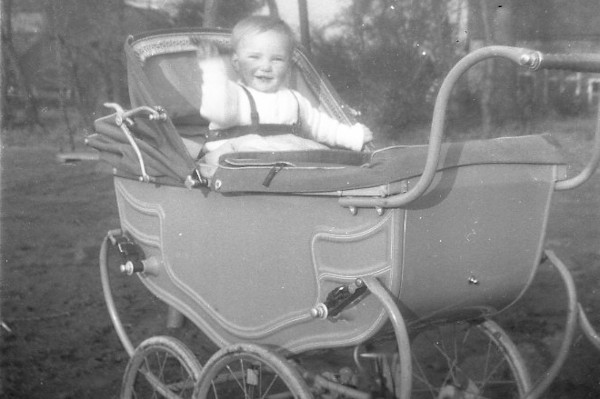
Not knowing the way home I clung onto my sister’s pram, hoping this would stop my mum and hopefully cause her to turn around and head back home. Somehow, instead, we made our way to the main gate and down the long drive to the entrance to the Infants’ school. We must have past headmistress Mrs. Wild’s office, (what a name!), turned right at the corridor then right again into the Reception class.
Miss Stevens - Reception
The Reception class was taken by Miss Stevens, a round-faced young lady with a slightly ruddy complexion. (I have been told that she was the daughter of the caretaker but I don’t know if that was true). The Reception class was very self-contained. To the North was a triangular area with toilet cubicles surrounded by wide but low wooden doors, so that the teacher could see if a child was having difficulties. Close by was an area to hang up clothing.
The Western end of the classroom had large doors, opening out onto a big patio with a sand pit in the centre. There must have been a store room for outdoor toys, I remember there being several tandem tricycles, for instance. If we used these we were able to go out onto the big playground to the South of the classroom, that wall being fully glazed.
I don’t think we had any desks but I expect there must have been tables and small chairs. My favourite activity was storytime. We would each pick up a small mat and place it in front of Miss Stevens, sitting at the Eastern end of the classroom. We would sit crossed-legged on our mat while she read from a book, perhaps from the Thomas the Tank Engine series. These books were printed in landscape format, ideal for railways.
Miss Green - Class 1
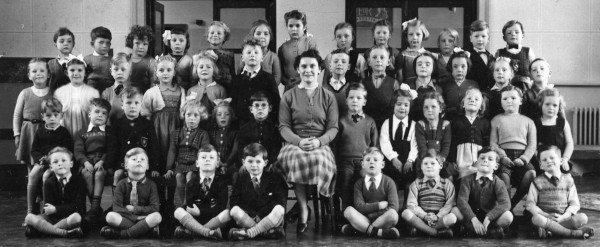
Leaving the Reception class we moved across the corridor to the first of two classrooms in a spur aligned with the South face of the Reception class. Further up the corridor were two identical spurs, each with two classrooms and with toilets at the far end.
Miss Green took this class. I remember we had a large wooden box with real carpentry tools, hammers and saws. I expect many of the children, particularly the boys, had probably already experienced using tools like this. We had a Lego-like toy 2, brown rubber bricks with eight ball-ended pegs on top, used just like Lego. There were also toys like Tap It Pictures, various brightly covered wood shapes that could be nailed to a fibre board with a wood hammer to make pictures. (Usually the hammer blows caused nailed in pieces to fall off!).
We must have started to learn to read here, using the ‘Janet and John’ series books. We would start off with the yellow Book One which we had to read to Miss green. If we could do that we would be given the next book in the series. I just couldn’t manage this book, I kept failing the test. Then one day to Miss Green’s surprise I read it right through and got my Book Two! Within minutes I was back and qualified for Book Three. By the end of the session I was on Book Six, which I think was a lot thicker and was made up of various stories like ‘The Five Brothers’. In retrospect I think my reading problem had been caused by the printed letters ‘a’ and ‘g’ not looking like those drawn by the teacher. It took the educationalists about another 20 years to work that one out.
We performed The Parade of the Tin Soldiers 3. The boys wore long trousers and my mum sewed a red ribbon down the outside seam. Most of us brought in a ‘pop-gun’ that most toy shops/news agents sold. It looked like a small rifle. One boy brought in a ‘space gun’!
Mrs Cornforth - Class Two
The next year I moved to Mrs. Cornforth’s class, the first classroom on the Northern-most spur. Here I remember helping make big class models of a town, a large ‘television’ with pictures drawn on a large bit of paper held between two rollers and making newspapers. Each classroom had its own ‘stock room’and they all had a camp bed in the corner if a child was feeling a bit unwell.
The school had some Malaysian trainee teachers visit, (probably in training at Wolverhampton, in preparation for Malaysian Independence) 4. The children in the next classroom had made a model of a Malaysian village and we trooped through to see it. We were shown a real cocoa pod, looking like a small Rugby football.
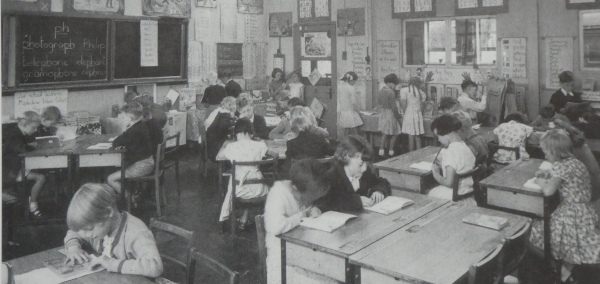
One day Mrs Cornforth asked us to take out our reading books. I said that I didn’t want to. (I remember at the time thinking “Why did you say that? You will be in big trouble”). She asked wht I wanted to do and I told her that I would like to paint. She asked if anyone else wanted to do that and one other boy put up his hand so she told us to fetch a double easel from the stock room! (I was surprised to find out years later that the incident had been photographed. I have no memory of every seeing anyone with a camera at school).
We performed something, I can’t remember what, but I dressed up as a rabbit. My mum made the costume. It had wire-edged ears and she dyed it brown. The costume was given away to another child for their play.
I remember some sort of informal school shop being set up in the entrance hall selling biscuits for ‘elevenses’. Usually I brought in something like a single digestive biscuit wrapped up in greasproof paper. One week I sold home-made cinder toffee for charity. It sold very well but Mum said that it sold for less than it cost to make so I didn’t continue in that ‘business’!
For school dinners we would be lined up in pairs and led through the ‘forbidden’ door separating the Infants' School from the Junior School. We would pass the Junior Assembly Hall on the left and the Junior School Headmaster’s office on the right, turn right and then straight on into the Infants’ dining hall. The serving hatches were at the same, Western end. The other side of the kitchen had hatches serving the Junior School dining hall.
Distractions
- Cows: The Infants' School playground looked out onto the fields of Lower Barn Farm where we sometimes saw and smelled cows.
- Planes: Beyond the farm was the City of Birmingham airport, (Elmdon). The biggest distraction here was when a piston aircraft, like the Douglas DC-3, took off. They were very noisy and took ages to clear the airport.
- Girls: Elizabeth and Rosamund were rivals for my attention and I was forced to choose. I chose Elizabeth, a local butcher's daughter. Rosamund’s parents moved shortly after so I guess I made the right choice.
Junior School
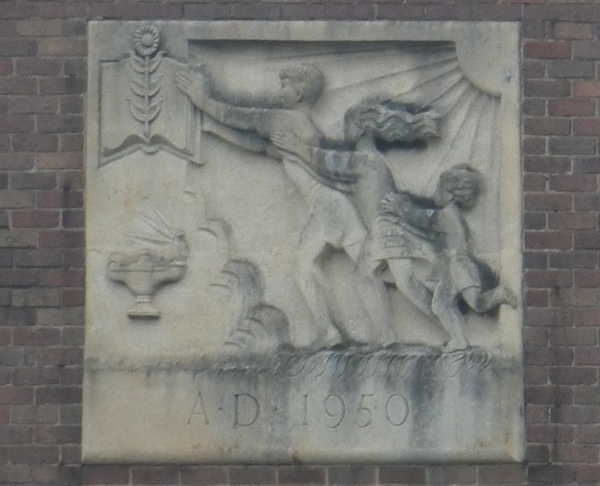
In 1956 I started in the Junior School. Several changes now took place, we no longer used the main entrance, with the long walk down the drive, we now walked further along Mapledene Road and used the pedestrian-only gate which led straight to the Junior School playground where we would at the sound of a whistle line up in class group lines, awaiting our class teacher to lead us to our classroom.
The headmaster was Mr Barlow. Reputedly he kept a cane in his room, though I never saw it, or for that matter, the inside of his office. Across a short stub corridor was the school secretary's office. This was sometimes used for medical inspections and I think, perhaps, for giving us all an antipolio vaccination.
Miss Hay - Class 1/1
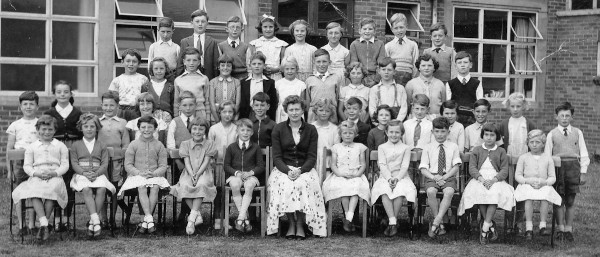
"James has done some interesting work. His general knowledge particularly is good."
While the Infants' School classes had been ordered by age the Junior classes were ordered by ability. As a consequence I lost many of my old classmates. I was placed in Class 1/1, taken by Miss hay, a young woman who liked dressing in long skirts and flat shoes. She came, she told us, from Kingston-upon-Hull, (not Hull!). I found her to be very nice. I remember her helping me with a hearing test that I had to repeat as I had panicked the first time. (You had to write down each word that you heard through a single-ear headphone. If you were still trying to work out a word that you had missed you would likely miss the next one, and so on).
Our classroom was right next to the dining hall and the exit to the playground. I recall being at that entrance and being faced with a choice of sitting with Elizabeth or playing football with the boys. The boys won.
While in this year the replica of the Mayflower had set sail from Plymouth and its position was reported in the newspapers 5. We took turns at putting pins in a map of the Atlantic. I remember the track looking something like a saucepan.
We had a preview of our next years class at the end of the last term. Miss Alexander took class 2/1. It was probably the second class on the ground floor of the main group of classrooms. The back wall was covered in displays relating to Alexander the great. I thought she had a bit of a cheek.
Mrs. Best - Class 2/1
"James seems to be most inattentive & becomes stubborn when corrected. I know he can do much better."
When we moved into that class properly Miss Alexander had now become Mrs. Best. She didn’t like me, I don’t know why. Subjects that I had been good at in 1/1 were now apparently beyond me. Mrs. Best was different in other ways. She smoked Du Maurier cigarettes, seen as a ‘superior’ brand at the time, and seemed to be the only teacher who drove a car, an Austin A35. Her dislike of me was transferred to my sister two years later.
Mr Bates - Class 3/1
"A pleasing result. His work in class has always attained a very satisfactory standard."
The following year saw me move to a class on the first floor, about as far from Mrs. Best's class as it was possible to be.
This class, 3/1, was taken by Mr Bates, a very round-headed man with spectacles and little hair. He said he came from South Africa and was a great fan of American poet Vachel Lindsay 6. He like to get the class to stand, like a choir, and recite poem, like The Congo with great emphasis on clear enunciation and rhythm.
Mr Bates organised the school football team, (boys only in those days). I was never really keen on football so I didn't trial for the team. The school team at the time was quite succesful and as a result a cabinet in the Junior School entrance hall held several league and tournament shields.
I think I had pretty neutral feelings about him. In any event my class marks went back up to the levels that I had in class 1/1 so he probably felt much the same about me.
Mr Wimpory - Class 4/1

"James has taken a keen interest in all his work & thinks deeply upon lesson topics. His scientific outlook could carry him far if only he could overcome his fear of arithmetic. A promising pupil."
Class 4/1 was taken by Mr Wimpory and his class literally was the top class, the only one on the third storey and with good views over the airport.
Mr Wimpory cycled to school, sometimes leaving his bicycle clips on. His tweed jacket had a lapel badge of the English Folk Dance Society 7. He was very keen on English Country Dancing. He had an interest in local history, being a member of an extra-mural group set up by the University of Birmingham and he helped research and produce the booklet Discovering Sheldon 8. As a consequence his classes were well-schooled on the medieval origins of Sheldon and the naming of local roads.
School Magazine
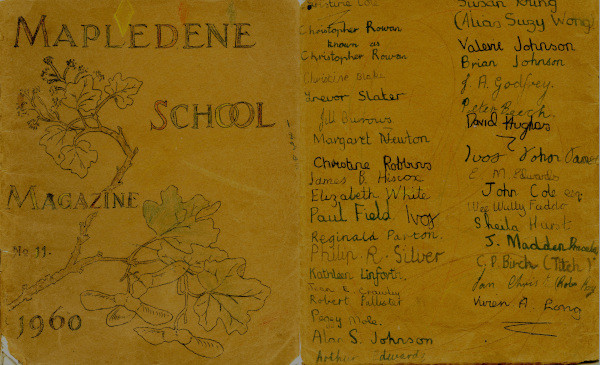
I think the school magazine was put together by Mr Wimpory. Everything had to be typed-up and a duplicating stencil cut for each double page. During my time the front cover artwork remained the same. A different colour paper would be used for each issue.
Practical Classes
I think from Year 4 on there were various practical classes taken by other teachers than our class teacher who taught everything else. The boys of (I think) the top two streams were grouped together and the same with the girls. As a boy I remember making balsa wood models, pretty much to our own designs. In Year 5 Mr Whiting took the class. He creaked when he walked, I believe he had what was called a ‘tin leg’. In Year 6 Mr Cullen took the class.
In Year 3 I think we did weaving with wool and raffia, probably as full class, i.e. boys and girls. At some point I had a series of special art classes with Mrs Cox. These were held behind or below the Junior Assembly Hall stage.
We played football in the playground with a small ball. A favourite game was British Bulldog. Boys would run between two parallel lines, (one was the corridor wall), and the boy that was ‘it’ had to ‘tag’ anyone that they could in transit. Those people would join the tagging team. The process would continue until everyone had been tagged. I was very good at this!
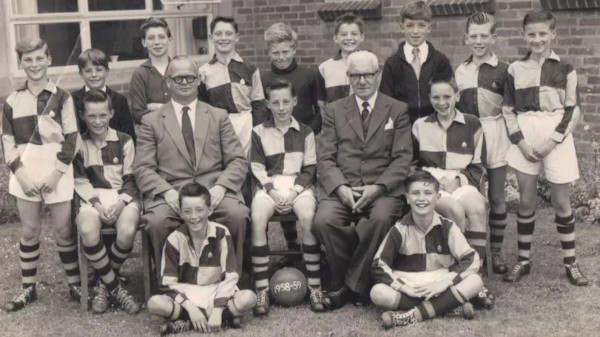
The school had a boys’ football team that did very well in the various leagues and tournaments, there being several cups and shields in a cupboard in the entrance hall. I am not sure how one got on the team, it wasn’t a game that I particularly liked, ditto cricket. I think at some point I took part in a High Jump club.
Montitors
Some pupils were chosen to perform special tasks. One went to a boy in Class 4/1 to ring the bell. That involved taking the handbell from the cabinet in the entrance hall, giving several rings on the ground floor, walking up to the first floor, repeating the process, then returning the bell to te cupboard. I never did this job. Each of the two main corridors, ground floor and first floor had a stock room in which things like guillotines were kept. Each class would have a guillotine monitor. When the teacher needed one the monitor would go and fetch one, being careful to hang up the class number on a hook above the now empty place. I did this job.
- Bell monitor: A boy from Class 4/1, who owned a watch, would collect the hand bell kept in the entrance hall and ring it three times on the first floor landing, then on the ground floor to mark break times. I never did this job.
- Guillotine monitor: The class teacher might appoint a monitor to fetch a guillotine from the ground or first floor stock rooms, as required. The number of the class borrowing the guillotine would be hung on a hook above the now empty space. Each stock room had two guillotines.
- Savings monitor: We were encouraged to buy Savings Stamps, ‘Prince Charles’ was priced at 2/6 (12.5p) and ‘Princess Anne’ at 6d (2.5p). The savings monitor would collect the money in a cardboard box and take it to the school secretary to be collected and recorded.
- Attendance monitor: Each class teacher was required to fill out a form for each child who didn’t attend school. The attendance monitor would collect the forms for the whole school and take them to the school secretary. Ultimately an Attendance Officer would turn up at the child’s home ‘to speak to the parent’. I loved doing this job as I got to roam the whole school and effectively I was operating under the authority of the headmaster!
Music and Dance
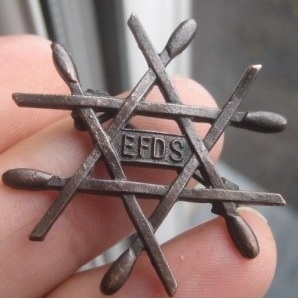
I enjoyed singing during my time at Mapldene, especially singing the descant parts! The first song that I remember singing was There Was An Old Woman Tossed Up in A Basket, most likely sung in the Infants' school. My mum thought that they were teaching us Latin as I sang 'Quo Fi' in the chorus rather than 'Quoth I'!
My favourite was There Was A Sailor Boy Called Jackie with the refrain 'Ho, Ho, Ho, Ho!'. Supposedly a 'traditional' song I have only found one source in the form that I remember. It might be a loose translation of the French song, Il était un petit navire, certainly the tune is very similar. Later we would sing traditional songs like The British Grenadier.
In the Junior school we would go down to the assembly hall and perform dance actions as instructed by the BBC programme Music and Movement. There were portable loudspeakers mounted on a wooden board, a couple of feet square, that could be plugged into a socket on the wall. There were probably sockets in each classroom but I only remember listening in the hall. I expect the radio receiver and amplifier was in the school secreary's office.
In Mr Wimpory's class we sat in boy/girl pairs. When the time came for dancing sessions we would cross-link hands and walk in a 'crocodile' down to the hall where we would perform such dances as the 'Circassian Circle'. I didn't like dancing. The only fun part was swinging around with your partner. Here both party's leant back, balancing each other. The more evenly-matched the pair the more effort could be put in. Unfortunately my desk-mate was very lightweight so I had to be careful not to fling her across the room or crush her hands.
(After leaving school I read a story about a teacher who was curious as to why the boys chose to dance with a larger, plain girl, rather than a smaller, pretty one. Eventually she asked the question and was told, "It's like driving a truck Miss!" Exactly!).
Classics
As each class filed into the hall in the junior school for the morning assembly it was usual for a piece of classical music to be played on a gramaphone near to the door. A favourite was Morning Mood from Edvard Grieg's Peer Gynt Suite.
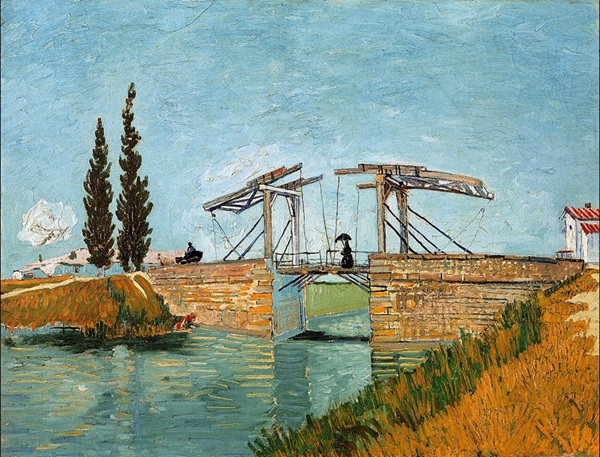
The wall of the junior school dining hall was lined with classical art works, the bridge at Arles being a memorable one. I don't remember anyone drawing attention to them, we queued for our food, sat at long tables, ate our dinner and left for the playground just outside the hall.
Auxiliary Staff
There weren’t any, apart from school secretary, caretaker and kitchen staff. Selected children would help with ‘prep’ work, cutting up paper for tests or art work and so on.
Postscript
Nearly 75 years on what has changed? Well the waste ground to the South of the school has become a cul-de-sac with housing and shops and houses extend along Mapledene Road, blocking the early view of the school. The local scout group has a lease on the North-East corner of the school grounds.
Lower Barn Farm and its cows has gone, replaced by part of Sheldon Country Park. As a result bushes surround the school fences to the South and East, limiting the view at ground level. The minor runway at the airport has been taken out of service and the main runway has been extended at both ends. Flights are more frequent but the aircraft are faster and quieter.
The school buildings have changed little, mainly in what was the Infant School with a nursery and fixed features in the playground. Access is now limited to the main entrance, the Junior School entrance being blocked off. Even the caretaker/service entrance is blocked off. No sneaking in after hours now!
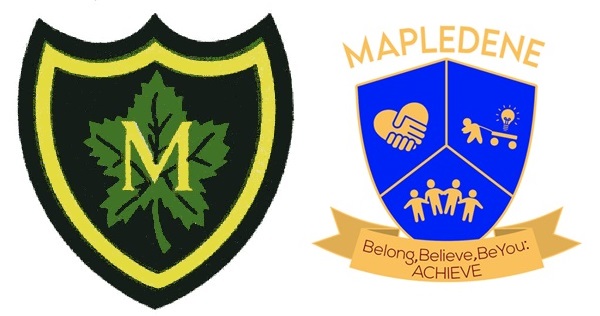
The adult-designed school badge has been replaced by a pupil creation, no doubt inspired by the school 'mission statement' - Belong, Believe, Be you, ACHIEVE, the classic iconography above the main doorway no doubt being too sophisticated for the present day staff.
The school uniform of old consisted of a green blazer, with badge and a yellow and green striped tie. In point of fact few pupils wore any uniform at all. Now, as with most English primary schools uniform is mandatory, blue 'tops' and grey 'bottoms'. The 'forest green' that we associated with maple trees (maple-dene) and the oaks that we played under long forgotten.
I hope, though, that today's children get as much enjoyment there as I did.
2. Most likely Mini-Brix.↩
3. The Parade of the Tin Soldiers: Composed by Léon Jessel (1871–1942) in 1897.↩
4. Brinsford Lodge, Wolverhampton was used as the Malayan Teacher Training College from 1955 to 1964.↩
5. Mayflower II sailed from Plymouth, Devon on April 20, 1957, recreating the voyage of Mayflower in 1620.↩
6. Vachel Lindsay (1879-1931). An American poet. The Congo has been said to be revolutionary in its use of sounds and rythmns.↩
7. English Folk Song and Dance Society: Founded in 1932 to preserve, promote and develop the English folk arts, and specifically song, tune and dance. Created by the merger of Folk-Song Society (1898) and the English Folk Dance Society (1911).↩
8. Discovering Sheldon by V.H.T. Skipp M.A. University of Birmingham.↩